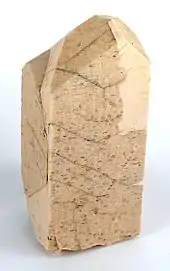endmember
English
WOTD – 7 November 2018
Etymology

A crystal of feldspar from Namibia. Feldspar can be described as a solid solution of the endmembers (sense 2) K-feldspar (or orthoclase), albite, and anorthite, with different types of feldspar having varying quantities of these minerals.
Pronunciation
- (Received Pronunciation) IPA(key): /ˈɛndmɛmbə/
Audio (Southern England) (file)
- (General American) IPA(key): /ˈɛndmɛmbɚ/
- Hyphenation: end‧mem‧ber
Noun
endmember (plural endmembers)
- A member at one end of a range or series made up of similar members.
- 1970, Arnold Reisman, “Condensed-vapor Phase Binary Diagrams Continued—Incongruently Vaporizing Systems”, in Phase Equilibria: Basic Principles, Applications, Experimental Techniques (Physical Chemistry; 19), New York, N.Y., London: Academic Press, →ISBN, section C (Immiscible Solid–Vapor Systems Exhibiting Congruently Vaporizing Compounds), page 370:
- Most significant is the observation that the vaporous for the more volatile end member occupies a decreasingly smaller portion of the diagram as the other end member becomes less volatile. Ultimately, when the less volatile end member is essentially involatile, the vaporous of the volatile end member may become microscopically small.
- 1990, Roy Chester, “The Transport of Material to the Oceans: The Atmospheric Pathway”, in Marine Geochemistry, London: Unwin Hyman, , →ISBN, page 43:
- The physicochemical processes that control the estuarine filter must therefore be considered to operate in terms of a framework involving particulate-dissolved recycling associated with three estuarine end-members, i.e. river water, sea water (which may consist of more than one component end-member), and sediments.
- 1990, K. A. Hunter, “Kinetics and Mechanisms of Iron Colloid Aggregation in Estuaries”, in Ronald Beckett, editor, Surface and Colloid Chemistry in Natural Waters and Water Treatment, New York, N.Y.: Springer Science+Business Media, , →ISBN, pages 48–49:
- In real estuaries, river water and seawater seldom mix together directly as endmembers. Rather, mixing takes place in a continuous manner that may be approximated by a series of water types, each of which has a salinity close to that of its neighbours.
- 2013, Ion Marques, Manuel Graña, “Greedy Sparsification WM Algorithm for Endmember Induction in Hyperspectral Images”, in José Manuel Ferrández Vicente, José Ramón Álvarez Sánchez, Félix de la Paz López, Javier Toledo Moreo, editors, Natural and Artificial Computation in Engineering and Medical Applications: […], Heidelberg: Springer-Verlag, , →ISBN, →ISSN, page 336:
- The Linear Mixing Model (LMM) assumes that the spectral signature of one pixel of the hyperspectral image is a linear combination of the endmember spectra corresponding to the aggregation of materials in the scene due to reduced sensor spatial resolution. Given the endmembers, unmixing algorithms compute the abundance coefficients providing sub-pixel resolution segmentations of the image.
- (mineralogy, specifically) A mineral that occurs at one end in a range of solid solutions.
- 1892, The Mineralogical Magazine and Journal of the Mineralogical Society, volume 10, London: H[umphrey Sumner] Milford, Oxford University Press, →OCLC, page 33:
- This group of tetragonal silicates seems to form a graduated series from akermanite to gehlenite, the constitution of the two end[-]members being (where R = Ca, with less Mg, Mn, Fe, Na2): / Akermanite, R4Si2O10, or R3(RSi)Si2O10, / Gehlenite, R3Al2Si3O10, or R3(Al3)Si3O10, […]
- 1989, I. A. Franchi, S. R. Boyd, I. P. Wright, C. T. Pillinger, “Application of Lasers in Small-sample Stable Isotopic Analysis”, in W. C. Shanks III, R. E. Criss, editors, New Frontiers in Stable Isotopic Research: Laser Probes, Ion Probes, and Small-sample Analysis: […] (U.S. Geological Survey Bulletin; 1890), [Washington, D.C.]: United States Government Printing Office, →OCLC, page 82, column 1:
- These data may therefore represent mixtures of gases from two (or more) distinct sources. One endmember appears to be slightly enriched in 84Kr and 132Xe relative to the vug quartz fluids; the other endmember is relatively enriched in 36Ar.
- 1997, H. Pichler, C. Schmitt-Riegraf, translated by L. Hoke, Rock-forming Minerals in Thin Section, London: Chapman & Hall, →ISBN, section 4.20 (Epidote Zoisite Group), page 156, column 1:
- Both the endmembers, epidote and clinozoisite, form the epidote sequence, in which part of the aluminium is progressively replaced by Fe3+; epidote is a typical mineral of the greenschist facies.
- 2001, Lucy E. Edwards, “Dinocyst Biostratigraphy of Tertiary Sediments from Five Cores from Screven and Burke Counties, Georgia”, in Geology and Paleontology of Five Cores from Screven and Burke Counties, Eastern Georgia (U.S. Geological Survey Professional Paper; 1603), Reston, Va.: U.S. Geological Survey; Washington, D.C.: United States Government Printing Office, →ISBN, page G23, column 2:
- The category includes poorly preserved specimens and specimens that do not fall into the endmember morphotypes of recognized species.
Alternative forms
Hyponyms
Translations
member at one end of a range or series made up of similar members
mineral that occurs at one end in a range of solid solutions
|
This article is issued from Wiktionary. The text is licensed under Creative Commons - Attribution - Sharealike. Additional terms may apply for the media files.